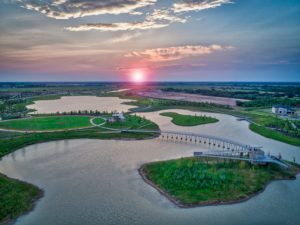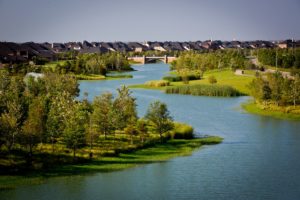The West Houston Association held a virtual forum on July 23rd, 2020 to discuss the interplay between water conservation (blue) and optimizing open spaces (green). A panel of conservation and recreation professionals discussed master-planned spaces and their impact on the region, moderated by Alia Vinson, Partner at Allen Boone Humphries Robinson LLP and Vice-Chair of the WHA Water Resources Committee.
Alan Steinberg, President and CEO of WHA, kicked off the event explaining the important role outdoor amenities play in our lives, especially amid the COVID-19 epidemic. Vinson sentiment saying, “having access to open green spaces and trails makes a huge difference to everyone’s well-being and mental health.”
 Tricia Brasseaux, Sr. Project Manager at Howard Hughes and Vice-Chair of the WHA Parks, Recreation and Open Spaces Committee reviewed the success of Bridgeland, one of the top master-planned communities in the nation. Developed by Howard Hughes, the Cypress community features recreational amenities, parks, trail systems, waterways, and Josey Lake. “We turned a stormwater detention facility into a highly aesthetic, functional and sustainable space,” said Brasseaux as she explained how the area was designed to capture and reuse stormwater, feed over 99% of the landscaped area, and remain accessible during floods.
Tricia Brasseaux, Sr. Project Manager at Howard Hughes and Vice-Chair of the WHA Parks, Recreation and Open Spaces Committee reviewed the success of Bridgeland, one of the top master-planned communities in the nation. Developed by Howard Hughes, the Cypress community features recreational amenities, parks, trail systems, waterways, and Josey Lake. “We turned a stormwater detention facility into a highly aesthetic, functional and sustainable space,” said Brasseaux as she explained how the area was designed to capture and reuse stormwater, feed over 99% of the landscaped area, and remain accessible during floods.

Rob Bamford from Johnson Development Corp and Chair of the WHA Quality Planned Development Committee, provided a developer perspective on Fulshear’s Cross Creek Ranch. Bamford, spoke of this space with pride, “It’s been very rewarding for us to watch our residents enjoy the open space we have created.” The goal for this community was to create self-sustaining natural resources and introduce more biodiversity. This is being accomplished by a polishing pond serving as a home to cranes, egrets, alligators, and even pelicans, reforestation efforts minimizing mowing and irrigation needs, and solar panels being utilized in recreational amenities.
Matt Baumgarten, Landscape Designer at SWA group, talked through innovation and implementation of these performative landscapes. When exploring the use of water in a space, Baumgarten introduced the term “invisible water” – the usage of water within our own homes. He also let everyone in on a landscaping secret to explain the importance of shaping water during stream restoration, saying, “The more curve you have, the more biodiversity you’re creating.”
Baumgarten’s suggestion for residents was to take advantage of their own landscapes. “Vacation is in your backyard,” he said. Biodiversity can be created on a smaller scale by growing gardens, placing bird feeders, and collecting stormwater.
Deborah January-Bevers, President and CEO of Houston Wilderness, spoke about regional conservation efforts. An eight-county conservation plan has been in the works to enhance services for flood control, air and water quality, erosion control, and recreation. With a goal of 24% protected or preserved land by 2040, the region is already more than halfway there, with much of that goal being met thanks to master-planned communities.
To improve green space in the region, January-Bevers expressed the importance of increasing the current 1% cap on bonds that can be sold by Municipal Utility Districts to create recreational facilities. She hopes to see legislation drafted in the future, but individuals who want to support the initiative can call their elected officials.
The next West Houston Association event will be our Flood Control Forum taking place virtually on August 4th from 7:30 a.m. – 9:00 a.m.
Special thanks to the event sponsors: Allen Boone Humphries Robinson LLP (ABHR); Howard Hughes; BGE; Johnson Development Corp; Schwartz, Page & Harding, LLP (SPH); LJA Engineering; R.G. Miller Engineers, Inc; Masterson Advisors LLC; LJA Engineering; and Si Environmental.
